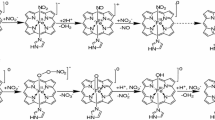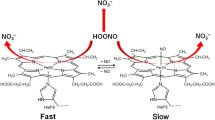Abstract
The influence of Cu2+ concentration, pH, and ionic strength of the solution as well as redox-inactive zinc ions on the rate of oxidation of sperm whale, horse, and pig oxymyoglobins (oxy-Mb) by copper ions has been studied. These myoglobins have homologous spatial structures and equal redox potentials but differ in the number of histidines located on the surface of the proteins. It was shown that oxy-Mb can be oxidized in the presence of Cu2+ through two distinct pathways depending on which histidine binds the reagent and how stable the complex is. A slow pH-dependent catalytic process is observed in the presence of equimolar Cu2+ concentration for sperm whale and horse oxymyoglobins. The curves of pH dependence in both cases are sigmoid with pK eff corresponding to the ionization. The process is caused by the strong binding of Cu2+ to His113 and His116, an analogous His residue being absent in pig Mb. In contrast, rapid oxidation of 10-15% of pig oxy-Mb is observed under the same conditions (fast phase), which is not accompanied by catalysis because the reduced copper is apparently not reoxidized. The complexing of Cu2+ with His97 situated near the heme is probably responsible for the fast phase of the reaction. The affinity of His97 for Cu2+ must be significantly lower than those of the “catalytic” His residues since the fast phase does not contribute markedly to the rate of sperm whale and horse oxy-Mb oxidation. Increasing copper concentration does not produce a proportional growth in the oxidation rate of sperm whale and horse oxy-Mbs. Which Cu2+ binding sites of Mb make main contributions to the His reaction rate at different Cu2+/Mb ratios from 0.25 to 10 is discussed.
Similar content being viewed by others
REFERENCES
Augustin, M. A., and Yandell, J. K. (1979) Inorg. Chim. Acta, 37, 11–18.
Hegetschweiler, K., Saltman, P., Dalvit, C., and Wright, P. E. (1987) Biochim. Biophys. Acta, 912, 384–397.
Margalit, R., Pecht, I., and Gray, H. B. (1983) J. Am. Chem. Soc., 105, 301–302.
Rifkind, J. M. (1974) Biochemistry, 13, 2475–2481.
Christova, P. K., Devedgiev I. D., Atanasov B. P., and Volkenstein, M. V. (1980) Mol. Biol. (Moscow), 14, 1088–1097.
Gray, R. D. (1969) J. Am. Chem. Soc., 91, 56–62.
Breslow, E., and Gurd, F. R. N. (1963) J. Biol. Chem., 238, 1332–1342.
Postnikova, G. B., and Tselikova, S. V. (1987) Mol. Biol. (Moscow), 21, 1040–1049.
Banaszak, L. J., Watson, H. C., and Kendrew, J. C. (1965) J. Mol. Biol., 12, 130–137.
Rousseaux, J., Dautrevaux, M., and Han, K. (1976) Biochim. Biophys. Acta, 439, 55–62.
Carver, J. A., and Bradbury, J. H. (1984) Biochemistry, 23, 4890–4905.
Postnikova, G. B., Shlyapnikova, E. A., Volkenstein, M. V., and Atanasov, B. P. (1981) Mol. Biol. (Moscow), 15, 526–537.
Brunori, M., Saggese, U., Rotilio, G. C., Antonini, E., and Wyman, J. (1971) Biochemistry, 10, 1604–1609.
Cher, M., and Davidson, N. (1955) J. Am. Chem. Soc., 77, 793–798.
Cocco, M. J., Kao, Y.-H., Phillips, A. T., and Lecomte, J. T. J. (1992) Biochemistry, 31, 6481–6491.
Bashford, D., Case, D. A., Dalvit, C., Tennant, L., and Wright, P. E. (1993) Biochemistry, 32, 8045–8056.
Rifkind, J. M., Lauer, L. D., Chiang, S. C., and Li, N. C. (1976) Biochemistry, 15, 5337–5343.
Lamy, M. T., Costa Ribeiro, P., Nascimento, O. R., and Bemski, G. (1976) FEBS Lett., 71, 29–32.
Moiseyeva, S. A., Postnikova, G. B., and Sivozhelezov, V. S. (2000) Biofizika, 45, 1019–1028.
Brantley, R. E., Smerdon, S. J., Wilkinson, A. J., Singleton, E. W., and Olson, J. S. (1993) J. Biol. Chem., 268, 6995–7010.
Ilan, Y. A., Czapski, G., and Meisel, D. (1976) Biochim. Biophys. Acta, 430, 209–224.
Author information
Authors and Affiliations
Rights and permissions
About this article
Cite this article
Moiseeva, S.A., Postnikova, G.B. Mechanism of Oxidation of Oxymyoglobin by Copper Ions: Comparison of Sperm Whale, Horse, and Pig Myoglobins. Biochemistry (Moscow) 66, 780–787 (2001). https://doi.org/10.1023/A:1010268813926
Issue Date:
DOI: https://doi.org/10.1023/A:1010268813926




